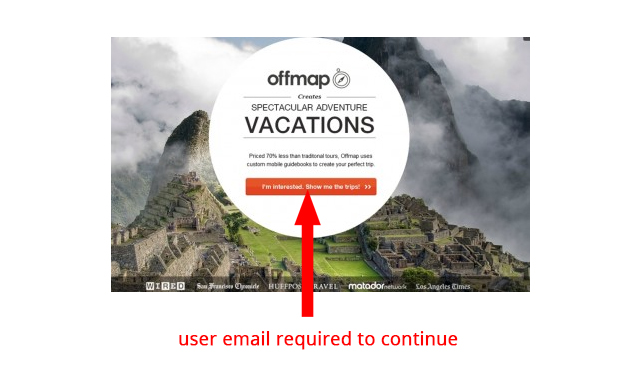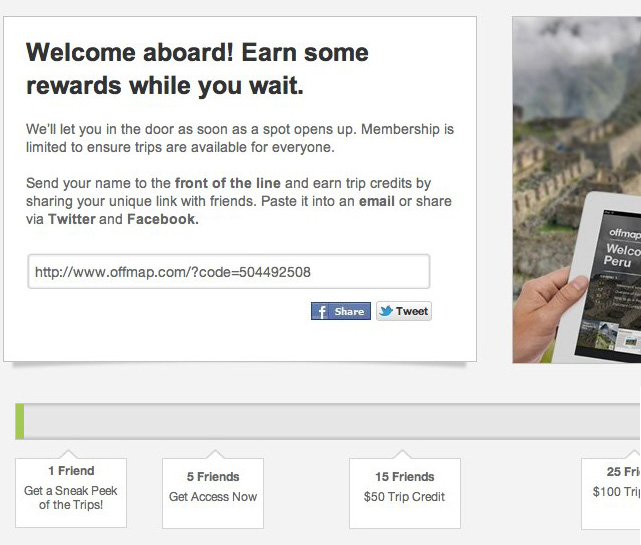Grow Your Ecommerce Company by Tracking These 4 Metrics
Wearables are hot right now. Almost everyone is using a FitBit or Apple Watch to track their fitness. I have a couple of friends that have really gotten into shape after implementing a wearable into their daily routine.
Why?
Because they’re tracking every move and relating that directly to a goal.
By analyzing each walk, each run, and each step they can clearly see what works for them, and then do more of it. This has resulted in fitness level improvement, which could be attributed to the well-known saying:
“What gets measured, gets managed.”Tracking certain metrics in your business can have the same effect.
As a growing ecommerce company, you’ve reached a level where customer acquisition is not as much of a barrier for you as it once was. Now what’s difficult is identifying what area to address in order to increase revenue.

My previous ecommerce business focused on providing affordable adventure travel packages guided by your smartphone instead of a tour guide. After my launch, and just weeks into the business, I began tracking several metrics. Because of the knowledge I extracted from this data, I was able to successfully increase my revenue just one month after I began tracking.
Related: How A Million Dollar Acquisition Offer Killed My E-Commerce Startup
This post will discuss some of my experience with metrics and data specific to my previous ecommerce company, and will also outline ways for you to implement the same strategy into your own business.
1. Shopping Cart Abandonment Rate
Offmap got off to a good start. With some early PR achieved pre-launch, we built a strong customer base and email marketing list within weeks of going live. After travel packages began selling, I decided I needed to monitor our abandonment rate – or how many people were adding an adventure package, then removing it and leaving the site.
Customers are fickle. Unless they are die-hard, committed fans of your brand, chances are they will change their mind during their purchase process on your site. There are various reasons for this, but in the case of Offmap, I figured out mine was related to the fact that users on my site were often just ‘browsing’ or planning for the future. They weren’t necessarily ready to buy right then. They would add the trip package to their cart, browse around, maybe view their cart, and then exit.
Sale lost.
Or was it?
Because they weren’t ready to buy, I began to rethink the way I thought about my abandoned cart rate. It didn’t mean I was losing that percentage in sales. I decided to attribute the percentage to users who were gathering information, but not yet ready to purchase. They were therefore qualified leads in my eyes.
I clearly needed to nurture this relationship. And my channel of choice was email. There’s nothing more personal than a message to your Inbox. Plus, Offmap required users to provide their email in step 1 of onboarding, so I already had a significant list to work with.

The approach that made the most sense to me was to build and send abandoned cart recovery emails. By showing my interested (but not convinced) customer what they left in their cart and coupling it with a personalized message and reiteration of my value proposition, I was able to convert 10% of my abandoned cart users to paying customers. Though that percentage may not seem very high, my product price tag was significantly higher than most consumer purchases (ranging from $800 – $1,000 USD), so 20% equated to a decent amount in recovered revenue.
It’s true this scenario may not apply to you, but a very popular reason for cart abandonment is “sticker shock” (the feeling a customer experiences once they see the total cost of their items). In fact, 56% of shoppers leave a site without making a purchase because of unexpected costs. (source)
56% of shoppers leave a site without making a purchase because of unexpected costsAn effective strategy in minimizing “sticker shock” and reducing the total amount as a barrier to conversion is to offer free shipping. Not only should you offer it, you need to make it visually apparent – front and center – that you are giving your customers this break. Though it may not be a significant reduction in overall charges, the psychological seed has been planted that you are, indeed, consuming some cost in this deal. When the customer sees their shipping charges zeroed out in the checkout process, they are more likely to follow through and complete the purchase. You can read a blog post I wrote about this subject, “Double-Down on Free Shipping: Why It’s Your Most Powerful Marketing Tool” for a deeper look and examples of implementation.
2. Cost per Acquisition
One metric I was very fortunate to tackle early on in Offmap’s life was my cost per acquisition (CPA). This metric was one I intentionally built into the social/viral part of my launch strategy to keep my CPA low from Day 1. By requiring users to “share” a certain URL to their Facebook network, they were able to get first access to our adventure packages, but only when 2 of their friends also signed up. I then incentivized sharing by increasing the benefits to the user: the more friends they signed up, the sweeter the deal for the user (I even gave away a free trip!). As Facebook sharing is free, my only costs here were programming my site and the social functionality to make sure I could validate users’ access via successful shares and signups. However, I still incurred the cost of the “reward” I was giving away (in this case a free trip).

At any rate, implementing this social sharing element into my intial launch reduced my CPA from what it would have been without the sharing incentive. Had I not implemented this, I would have faced much higher costs in ad spend to acquire new users, where “word of mouth” from social is free.
You can determine your cost per acquisition by taking your total marketing spend over a period (year/month), and then dividing it by the number of customers you had during that span. The total marketing spend should also be categorized by channel since you will have multiple channels where you are directing marketing funds (AdWords, Facebook Ads, Twitter Ads, content marketing, etc.). For example, if you spend $100 on Google AdWords and acquire 10 customers from that channel, your CPA would be $10 per customer for your AdWords channel.
Though you may not have even known what CPA meant when you launched your ecommerce business, it’s not too late to begin monitoring this metric. Here are a few questions to ask yourself to determine where and how you can identify opportunities to lower your cost per acquisition:
- Are the products on my homepage resonating with my target demo?
- What are my best performing products?
- Are the people clicking on my ads being directed to targeted content?
- Are my customers sharing a certain product on social media more than others?
- Do I have channels that aren’t pulling their weight?
Once you have an answer to these questions, be aggressive. By optimizing your content based on an analysis of your current CPA, you can lower your cost significantly. Implement unique tracking URLs (here’s a helpful video tutorial) or offer unique discount codes. Place your best performing products on your home page. Monitoring customers’ response to your changes will give you incredible insight into what they actually want to see and buy.
3. Customer Lifetime Value
As previously mentioned, my product at Offmap has a higher price point than many online retail websites. My typical customer would purchase once, maybe twice, within a 12-month period. Even though my customers would make just one purchase per year, their lifetime value to my business was no less important. In fact, it was just the opposite: I needed to do everything in my power to please these customers and make their experience as high quality as possible, in hopes they would return, spread the word about Offmap, or both.
A customer’s lifetime value can be thought of as the dollar value of a customer relationship (source). Ideally, you want to have a positive number for your CLV that is also greater than your CPA. Determining your CLV is typically done by answering these three questions:
- What is my customer acquisition cost (CPA)?
- What is my annual profit per customer?
- What is my customer retention rate (CRR)?
Check out this SlideShare presentation for accurately calculating this number for your business:
My latest upload : A step by-step guide to calculating customer l… on @slideshare http://t.co/PT6SL5dWb3 via @SlideShare
— Geoff Fripp (@GeoffFripp) November 26, 2014
Once you’ve accurately determined your CLV, it’s time to break the data down even further. Filtering these results by channel will provide you with insight into which channels are nurturing a higher CLV.
For example, if your Facebook Ads CLV is $500 but your Instagram CLV is $800, it would be wise to increase spend in your Instagram initiative as it’s a better-performing channel.
With Offmap, I was able to determine that my highest-value CLV channel was Facebook. This is what spawned my incremental rollout of sharing initiatives. As mentioned, I originally offered early access to users who successfully signed up 2 friends. Later, I began rolling out greater sharing initiatives (successfully sign up 5 friends, get an entry for a free trip). As a result my CPA lowered and my CLV increased.
4. Repeat Purchase Rate
Only 32% of customers place a second order in their first year as a customer. (source)
With data suggesting that many customers are coming to your ecommerce website to simply buy once and fulfill a need, it’s difficult to determine if your repeat purchase rate is healthy or something you can optimize. First, Let’s look at how to calculate it:
Customers that have purchased a second time / total customers.
12 months into Offmap, my repeat purchase rate was around 15%. Though this may not seem compelling, in the travel industry companies need a very long horizon for analyzing and improving this number as Most people only take one trip per year. Still, I wanted to improve this figure. My initial instinct was to hit the most personal space: the inbox. I took the following steps to connect with my customers who had already made one purchase:
- Analyze their purchase (what are they interested in?)
- Segment my email list to personally relate to specific interests
- Implement this data into my ad campaign strategy (products with greater interest and greater repeat purchase rate should be highlighted more)
Existing customers are 14x more likely to buy as a result of marketing. (source)
Figuring out who those customers are is the most difficult part. From a business development perspective, learning about your customer is one of the best investments in your ecommerce business. Tracking your repeat purchase rate is crucial to lowering your costs. If I hadn’t learned what adventure packages drew my customers in (certain price point, specific countries), and what packages were purchased repeatedly (certain price point, proximity), Offmap would have drained itself of cash after the first year solely in marketing costs.
Related: 6 Ways to Kill Your Ecommerce Startup
What Gets Measured Gets Managed
Tracking these 4 metrics can improve your bottom-line by shedding light on your customer behavior and highlighting areas for improvement. Think of these metrics as a “wearable for your business” – you’re tracking its health and measuring your progress and growth.
What metrics have you been tracking for your ecommerce growth? Have you tried any of the ones in this post? I’d love to hear from you in the comments.
[rad_rapidology_inline optin_id=”optin_1″]






